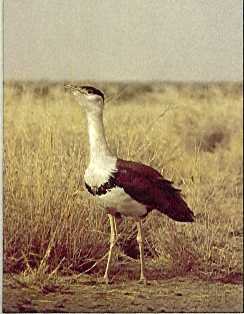Great Indian Bustard (Ardeotis nigriceps) - Wiki Great Indian Bustard
From Wikipedia, the free encyclopedia
Order: Gruiformes
Family: Otididae
[Photo] Great Indian Bustard (Ardeotis nigriceps) at Ghatigaon Sanctuary, Madhya Pradesh. Author: Laxman Burdak (http://en.wikipedia.org/wiki/User:LRBurdak).
Copyright (C) 2006 Laxman Burdak
Permission is granted to copy, distribute and/or modify this document under the terms of the GNU Free Documentation License, Version 1.2 or any later version published by the Free Software Foundation; with no Invariant Sections, no Front-Cover Texts, and no Back-Cover Texts. A copy of the license is included in the section entitled "GNU Free Documentation License". |
The
Great Indian Bustard (
Ardeotis nigriceps) is a
bustard found in India and possibly Pakistan. It is a large ground dwelling bird with a long neck and long bare legs and some what similar to a young
Ostrich. Its standing height is more than a meter, wing span is 2.5 mts. and weighs about 18 kg.
It is a large, brown and white bird, the male is about 122 cm (48 in)in length,its weight is 18???32 lb (8???14.5 kg) and the female 92 cm (36 in)in length, its weight is 7.8???15 lb (3.5???6.75 kg). The sexes are similar in appearance although the male is deep sandy buff coloured. The crown of the head is black and crested. In the female which is smaller than the male, the head and neck are not pure white and the breast band is either rudimentary or absent.
The male is polygamous. The female lays only single egg once in a year and incubates it for about 27 days. Nests are situated in the open ground and males take no part in incubation or care of the developing young. The eggs are at risk of destruction from other animals. The fledglings tend to remain with their mother until the following breeding season.
It lives in arid and semi-arid grasslands.It is inhabitant of the open country having thorny bushes and tall grass interpassed with cultivation.It is omnivorous in diet mainly relying on grass, small shrubs, insects, rats, grams, groundnuts, millets etc. depending on the season.
The current population is estimated at less than 1,000. The main threat to its existence is habitat loss. The bird is found in Rajasthan and Madhya Pradesh states of India. Ghatigaon and Karera santuaries in Madhya Pradesh had sizeable population earlier but now there is no
Great Indian Bustard seen in Karera wildlife sanctuary in Shivpuri district. The
Great Bustard was identified in 1978 at Nanaj, 18 km from Solapur in Maharashtra by Mr B.S. Kulkarni. Nearly 24
bustards are now seen in Nanaj sanctuary. There has been some assaults recently on the habitat of the bird.and one bird was found injured and eventually died.
http://en.wikipedia.org/wiki/Great_Indian_Bustard| The text in this page is based on the copyrighted Wikipedia article shown in above URL. It is used under the GNU Free Documentation License. You may redistribute it, verbatim or modified, providing that you comply with the terms of the GFDL. |
